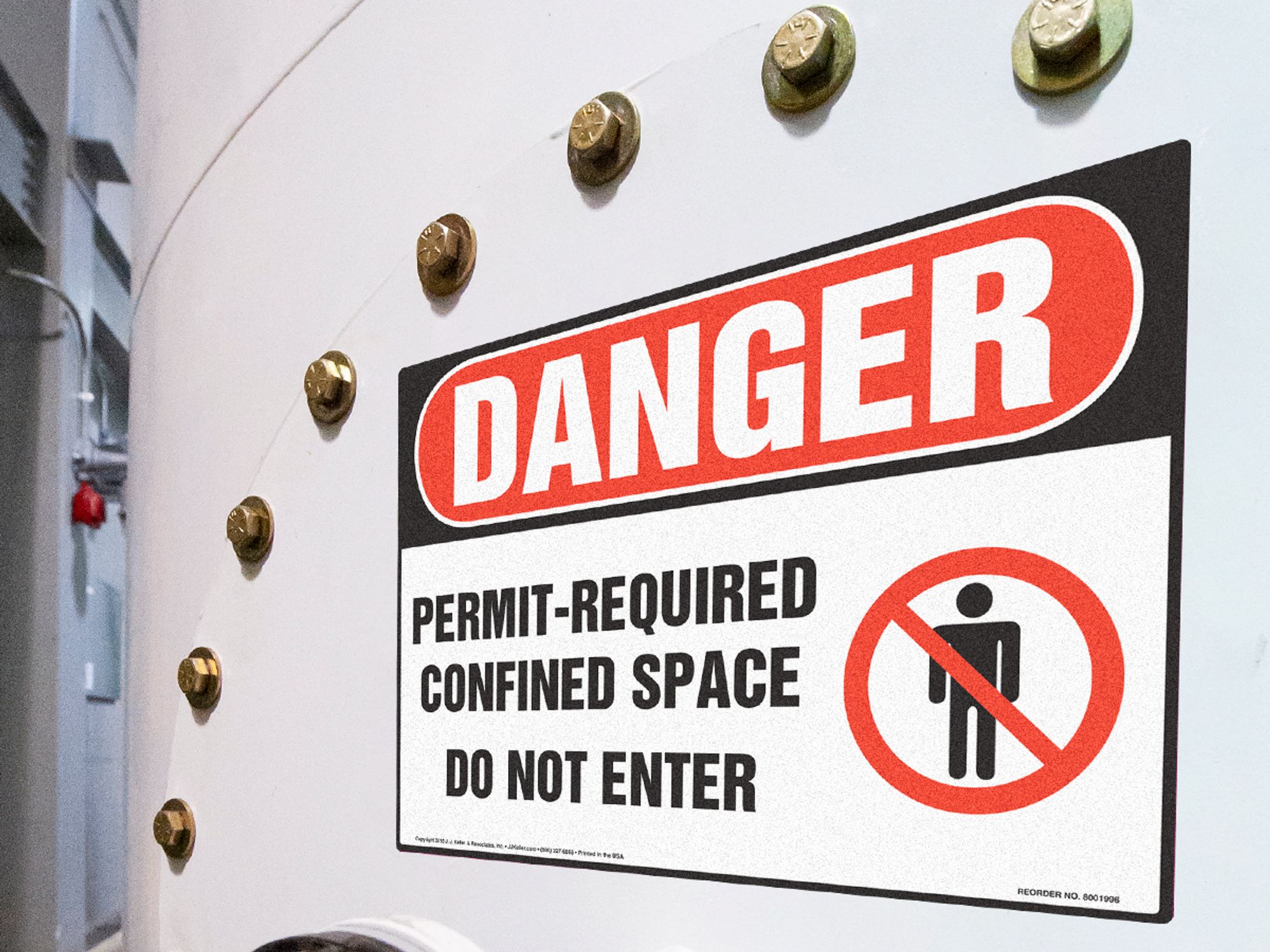Accident prevention signs

- Safety signs help to prevent death, injury, illness, and property damage in situations where serious hazards can’t be eliminated or reduced through other control measures.
- OSHA and ANSI both have regulations that apply to safety signs.
In many work settings, operations may present hazards to employees. That’s why it’s critical to make every effort to protect them. Safety signs are a key part of those efforts.
Purpose
Safety signs may not seem necessary when the hazards in a facility seem “obvious.” However, what appears visible to someone who’s familiar with the workplace may not be as evident to a new or transferred employee, contractor, or visitor.
Signs are administrative control measures. When serious hazards cannot be eliminated or reduced through other control measures, safety signs play a critical and active role to drive injuries and illnesses down, protect property, and reduce costs.
Signs not only communicate, they give employers the power to alert, prohibit, instruct, warn, inform, reinforce, and remind. What’s more, they reflect the safety culture of an organization. Safety professionals or supervisors cannot be there every minute to warn workers of hazards. When the right sign is in the right place, it helps to prevent injury and illness.
Signs are no substitute for other control measures, but they can take an active role in the overall safety and health program and be a smart investment towards greater safety and health success and savings.
Related regulations and standards
Signs are not just a good idea for the work setting. Often, they’re required. In recent years, the average proposed penalty ranged from $3,700 to $4,100 per Occupational Safety and Health Administration (OSHA) sign violation. Yet, a single failure to post a sign can and has cost employers tens of thousands of dollars in fines, and more than one sign violation means costs multiply.
Here’s a case in point of sign regulations in action. OSHA issued a $42,000 proposed penalty to a food company for failing to post “safety instruction signs” in areas where combustible food ingredients are processed. The agency explains that the ingredients, when processed, create a fire and explosion hazard; therefore, signs must be used to provide employees with instructions about safety measures, per 29 CFR 1910.145(c)(3).
To ensure sign compliance, the applicable federal OSHA regulations at 29 CFR 1910 to 1928 must be reviewed to ensure sign compliance. Sign requirements are sprinkled throughout those regulations for general industry, maritime, construction, and agriculture. Examples include, but are not limited to, the following:
- Accident prevention signs — 1910.145, 1915.91, 1917.128, 1926.200, and 1928.21.
- Bloodborne pathogens — 1910.145, 1910.1030, 1915.91, and 1915.1030.
- Blast areas — 1926.905.
- Clearance limits — 1910.176.
- Confined spaces — 1910.146, 1918.93, and 1926.1203.
- Cranes in construction — 1926.1422 and 1926.1424.
- Dipping and coating operations — 1910.125.
- Electrical hazards — 29 CFR 1910 Subpart S, 1917.1, 1918.1, and 1926 Subpart K.
- Exits and exit routes — 1910.37 and 1926.200.
- Falling materials — 1926.850.
- Fire extinguishers — 1910.157.
- Fire hose reels and cabinets — 1910.158.
- Hazard communication — 1910.1200, 1915.1200, 1917.1, 1918.1, 1926.59, and 1928.21.
- Manlifts — 1910.68.
- Nonionizing radiation — 1910.97.
- Nonpotable water — 1910.141, 1915.88, and 1926.51.
- No smoking — 1910.106, 1910.107, 1910.110, and 1910.125 (for example).
- Pulp, paper, and paperboard mills — 1910.261.
- Radiation areas — 1910.1096.
- Spray finishing — 1910.107.
- Toxic and hazardous substances — 29 CFR 1910 Subpart Z, 1915 Subpart Z, 1917.1, 1918.1, 1926.60, 1926.62, 1926 Subpart Z, and 1928.1027.
- Welding and cutting — 1910.253.
State and local codes and regulations may also require signs.
Note: Section 1910.145 calls for signs or symbols (or other effective means, such as training) when failure to post signs or symbols may lead to accidental injury or property damage in general industry or shipyard operations. This is a catch-all requirement for posting signs near hazards.
In addition to OSHA regulations, the following American National Standards Institute (ANSI) consensus standards are related to signs:
- ANSI Z35.1-1968 — Specifications for Accident Prevention Signs.
- ANSI Z53.1-1967 — Safety Color Code for Marking Physical Hazards.
- ANSI Z535.1-2006(R2011), -2017, and -2022 — American National Standard for Safety Colors.
- ANSI Z535.2-2011, -2011(R2017), or -2023 — American National Standard for Environmental and Facility Safety Signs.
- ANSI Z535.3-2011, -2011(R2017), or -2022 — American National Standard for Criteria for Safety Symbols.
For construction, OSHA 29 CFR 1926.200 explains that ANSI Z35.1-1968 and ANSI Z535.2-2011 contain rules in addition to those specifically prescribed by 1926.200. Employers in construction must follow either ANSI Z35.1-1968 or ANSI Z535.2-2011, with respect to such additional rules, OSHA says.
Editor’s note: The ANSI information provided in this topic is explanatory. Please review the originating ANSI standards for definitive compliance information. Learn how to get access to the above ANSI standards through four resources: 29 CFR 1910.6, ibr.ansi.org, www.archives.gov/federal-register/cfr/ibr-locations.html, and webstore.ansi.org/.
